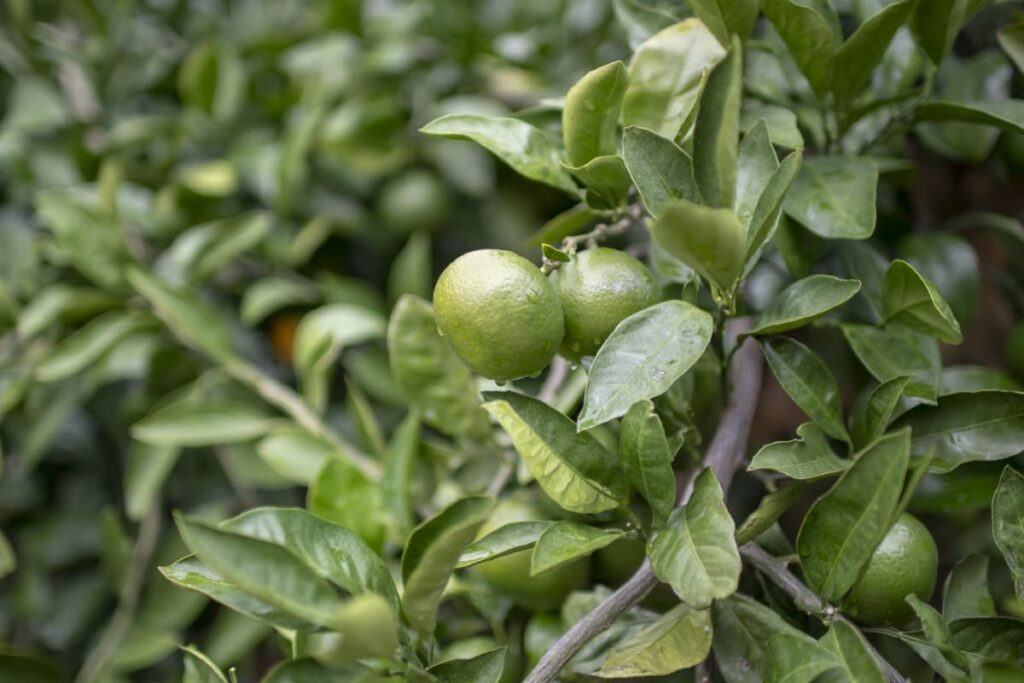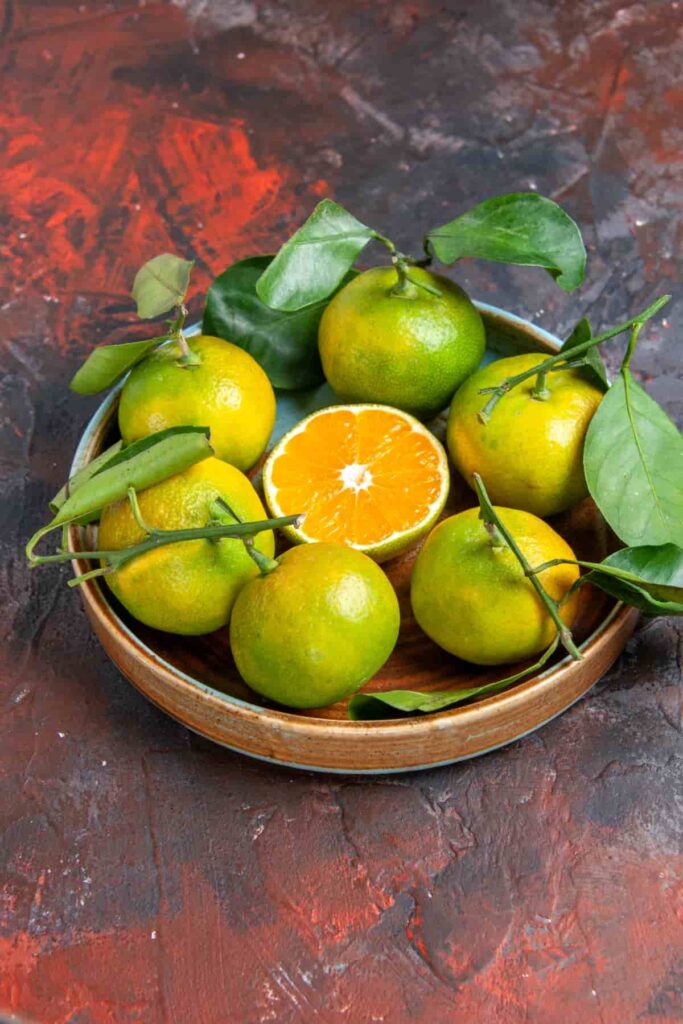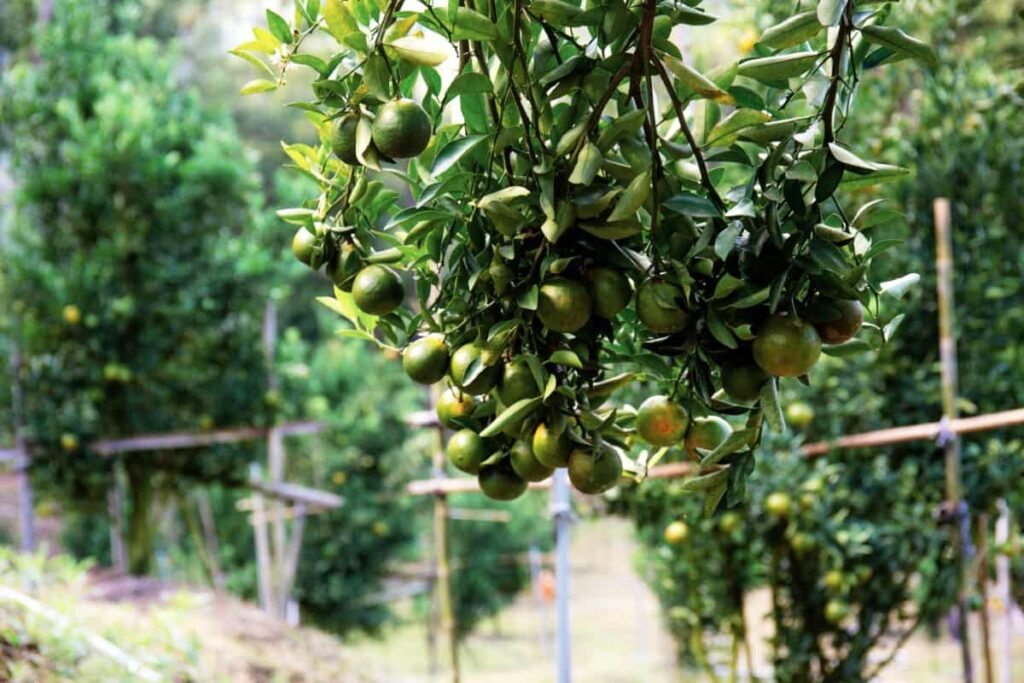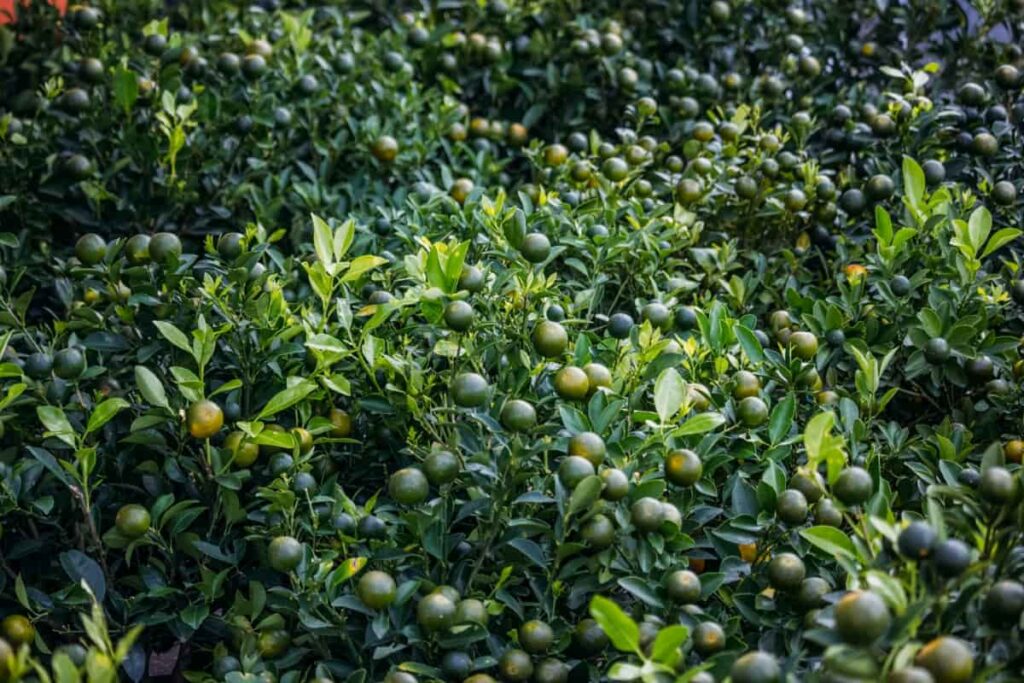Calamansi is a versatile citrus fruit that can be easily grown in your backyard. Calamansi, with its tangy and refreshing flavor, has become a staple ingredient in Filipino cuisine. It is not just a fruit but also a symbol of tradition, health, and versatility. Growing Calamansi in your garden or even in pots can bring a multitude of advantages.

Calamansi Fruit
Calamansi Tree Profile
| Name | Calamansi |
| Scientific name | Citrus microcarpa |
| Origin | Philippines |
| Soil pH | 5.5 and 6.5 |
| Sunlight | 6 hours a day |
| Appearance | Small round fruit resembling limes |
| Flavor | Tangy and acidic with hints of sweetness |
| Calamansi Price Per Kg | 81.550 PHP/kg |
| Lifespan | Live up to 20 years or more |
Calamansi Scientific Name
Calamansi, scientifically known as Citrus × microcarpa, is a citrus hybrid that holds great economic significance in the Philippines. The hybrid nature of Calamansi is reflected in its scientific name – Citrus × microcarpa. The “Citrus” genus refers to the larger group of citrus fruits that includes oranges, lemons, and grapefruits.
The “×” symbol indicates that Calamansi is a hybrid between two different species within the Citrus genus. As for “microcarpa,” this term describes the characteristic small size of the fruit itself. Calamansi typically grows to about 1-2 inches in diameter and has a thin rind with juicy flesh inside.
Calamansi Other Names
Calamansi, the versatile and tangy fruit that is native to the Philippines, goes by various other names across different regions. This versatile fruit is also commonly referred to as Kalamansi, Calamondin, Philippine Lime, or Philippine Lemon.
Calamansi Fruit Taste
Calamansi fruit is a small citrus wonder that packs with the most flavor. Its taste can be described as an exquisite blend of sweetness with hints of tanginess that make your taste buds dance with delight. The unique flavor profile of Calamansi makes it incredibly versatile in the culinary world. Its zesty taste adds brightness to savory dishes like grilled meats and seafood while also enhancing the flavors of desserts and beverages.
In case you missed it: High Yield Hybrid Lemon Varieties in India

Calamansi Fruit Benefits and Uses
Calamansi fruit, with its citrusy flavor, is not only a delicious addition to various dishes and beverages but also offers numerous health benefits. One of the key benefits of Calamansi is its ability to strengthen the immune system. The high vitamin C content helps in fighting off infections and reducing the severity of common colds and flu. Regular consumption of Calamansi juice can help keep illnesses at bay. The antioxidants present in Calamansi are beneficial for maintaining healthy skin.
Difference Between Lemon and Calamansi
Calamansi and lemon may look similar at first glance, but when it comes to taste and usage, they have some distinct differences. Taste-wise, Calamansi has a unique flavor profile that sets it apart from lemons. While lemons are known for their tangy and acidic taste, Calamansi offers a more subtle and slightly sweeter flavor. In terms of size, Calamansi is much smaller than lemons. Another notable difference between Calamansi and lemon lies in their scientific names. Calamansi goes by the name Citrus × microcarpa, while lemons belong to the Citrus limon family.
Climate and Soil Requirements for Calamansi
The success of growing Calamansi depends greatly on the climate and soil conditions. Calamansi trees thrive in tropical climates with temperatures ranging from 24°C to 35°C. They need full sun exposure for at least six hours a day. Calamansi prefers well-draining sandy loam or clay loam soil with a pH level of 5.5 and 6.5.
Propagation and Planting Calamansi: Growing from Seeds and Cuttings
There are a few easy ways to plant Calamansi. To grow Calamansi from seeds, start by collecting fresh seeds from ripe fruits. Rinse them thoroughly and let them air dry for a day or two. Then, plant the seeds in well-draining soil about an inch deep. Another method is propagating Calamansi using cuttings. Take healthy stem cuttings from mature trees during the dormant season.
Make sure each cutting has at least three nodes, and remove any leaves near the bottom before planting it in a pot filled with soil mix. Regardless of which method you choose, germination can take several weeks or even months for some varieties. Once your seedlings or cuttings have established roots and reached a suitable size, transplant them into larger pots or directly into your garden.
Pruning and Maintenance of Calamansi Trees
Regular pruning helps shape the tree, promotes air circulation, and removes dead or diseased branches. When it comes to pruning Calamansi trees, it’s best to start when the tree is young. Begin by removing any suckers or shoots that emerge from below the graft union. These shoots can divert energy away from the main tree and affect its overall health. Additionally, prune back any crossed or rubbed branches to prevent bark damage.
Pest and Disease Control for Calamansi
One common pest that affects Calamansi trees is the citrus leaf miner. To control this pest, you can use organic insecticides or remove affected leaves. Another common issue is aphids, which are small insects that feed on the plant sap. Fungal diseases like anthracnose and powdery mildew can also affect Calamansi trees. Proper sanitation practices like removing infected plant parts, promoting good air circulation, and applying fungicides, when necessary, can help prevent these diseases.
Harvesting and Yield of Calamansi
Once your Calamansi tree has reached maturity, it will start bearing fruit. The time to harvest is when the fruits have turned a bright orange color. To harvest Calamansi, twist or cut the fruit from the branch using pruning shears or scissors. Be careful not to damage any new buds or branches while doing so.
In case you missed it: Orange Cultivation Information Guide

The yield of Calamansi can vary depending on various factors such as climate and care given to the trees. On average, a mature Calamansi tree can produce up to 500 fruits per year. That’s quite impressive, considering its small size compared to other citrus trees.
Growing Calamansi in Pots
Calamansi, with its compact size and beautiful foliage, is a perfect fruit tree to grow in containers or pots. To start growing Calamansi in pots, select a pot and then fill it with a soil mix. Place your potted Calamansi tree in a sunny location that gets 6 hours of daily sunlight. Watering is crucial when growing Calamansi in pots. Regular fertilization is necessary for healthy growth and optimal fruit production. With proper care and attention, your indoor-grown Calamansi tree can thrive year-round and offer you an abundant supply of delicious fruit right from your very own living space.
Calamansi Growing Stages
Germination: The first stage is germination, where the seed starts to sprout and form roots. This usually takes around two to three weeks, depending on environmental conditions and seed quality.
Seedling Stage: Once the Calamansi seed has germinated, it enters the seedling stage. During this phase, the plant develops its true leaves and continues to grow stronger roots.
Vegetative Growth: As the Calamansi plant matures, it enters the vegetative growth stage. Here, you’ll notice significant leaf expansion as well as branch development.
Flowering: After several months of vegetative growth, your Calamansi tree will begin to produce beautiful white flowers that emit a delightful fragrance. These flowers are an indication that fruit production is just around the corner.
Fruit Development: Once pollination occurs after flowering (often facilitated by insects), tiny green fruits start forming on your Calamansi tree branches. The fruits gradually enlarge in size over several months until they reach their full ripeness.
Harvesting Phase: Finally ripe for harvest! Calamansi fruits turn bright orange when fully matured—a sign that they’re ready to be picked and enjoyed in various culinary delights.
Frequently Asked Questions (FAQ) on Calamansi Tree
How Long Does It Take for a Calamansi Tree to Bear Fruits?
Generally, it takes around two to three years for a Calamansi tree to start bearing fruits. Patience is key.
Should I Prune My Calamansi Tree?
Yes, regular pruning helps maintain its shape and encourages better air circulation within the canopy.
Can I Grow Calamansi Indoors or in Containers?
Definitely, ensure that your container has good drainage holes and use a well-draining potting mix specifically formulated for citrus plants.
In case you missed it: Tangerine vs. Orange: Know the Key Differences

Conclusion
Calamansi is a small citrus fruit that holds immense importance in Filipino cuisine and culture. This unique fruit is not only used for its tangy flavor but also its numerous health benefits. Growing your own Calamansi tree can be an exciting endeavor. To ensure successful growth, it’s important to understand the climate and soil requirements necessary for these plants’ survival.
- Sheep Farming Business Plan for Beginners
- Aquaponic Farming at Home: A Step-By-Step Guide
- Profitable Village Farming Business Ideas in 2024
- High-Yield Aquaculture: Fast-Growing Fish for Farming
- Effective Fish Pond Construction Techniques for Beginners
- Irrigation and Water Management in Pineapple Farming
- Blossom to Harvest: Mastering Flowering and Pollination in Papaya Farming
- Pig Fattening Essentials: From Selection to Sale for Beginners
- Raising Wagyu Cattle: A Complete Guide for Premium Beef Production
